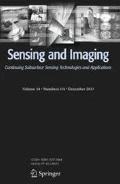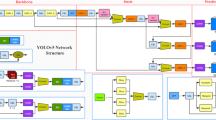Abstract
Color is one of the most stable attributes of vehicles and often used as a valuable cue in some important applications. Various complex environmental factors, such as illumination, weather, noise and etc., result in the visual characteristics of the vehicle color being obvious diversity. Vehicle color recognition in complex environments has been a challenging task. The state-of-the-arts methods roughly take the whole image for color recognition, but many parts of the images such as car windows; wheels and background contain no color information, which will have negative impact on the recognition accuracy. In this paper, a novel vehicle color recognition method using local vehicle-color saliency detection and dual-orientational dimensionality reduction of convolutional neural network (CNN) deep features has been proposed. The novelty of the proposed method includes two parts: (1) a local vehicle-color saliency detection method has been proposed to determine the vehicle color region of the vehicle image and exclude the influence of non-color regions on the recognition accuracy; (2) dual-orientational dimensionality reduction strategy has been designed to greatly reduce the dimensionality of deep features that are learnt from CNN, which will greatly mitigate the storage and computational burden of the subsequent processing, while improving the recognition accuracy. Furthermore, linear support vector machine is adopted as the classifier to train the dimensionality reduced features to obtain the recognition model. The experimental results on public dataset demonstrate that the proposed method can achieve superior recognition performance over the state-of-the-arts methods.







Similar content being viewed by others
References
Gao, Y., & Lee, H. J. (2016). Local tiled deep networks for recognition of vehicle make and model. Sensors, 16(2), 226.
Chen, L. C., Hsieh, J. W., Yan, Y., & Chen, D. Y. (2015). Vehicle make and model recognition using sparse representation and symmetrical SURFs. Pattern Recognition, 48(6), 1979–1998.
More, N., & Tidke, B. (2015). License plate identification using artificial neural network and wavelet transformed feature selection. In 2015 IEEE international conference on pervasive computing (ICPC) (pp. 1–5).
Wang, Y. C., Han, C. C., Hsieh, C. T., & Fan, K. C. (2014). Vehicle color classification using manifold learning methods from urban surveillance videos. EURASIP Journal on Image and Video Processing, 2014(1), 1.
Chen, R., Hawes, M., Mihaylova, L., Xiao, J., & Liu, W. (2016). Vehicle logo recognition by spatial-sift combined with logistic regression. In Proceedings of fusion 2016.
Huttunen, H., Yancheshmeh, F. S., & Chen, K. (2016). Car type recognition with deep neural networks. arXiv preprint arXiv:1602.07125.
Baek, N., Park, S. M., Kim, K. J., & Park, S. B. (2007). Vehicle color classification based on the support vector machine method. In International conference on intelligent computing (pp. 1133–1139). Berlin: Springer.
Kim, K. J., Park, S. M., & Choi. Y. J. (2008). Deciding the number of color histogram bins for vehicle color recognition. In Asia–Pacific services computing conference, 2008. APSCC’08, IEEE (pp. 134–138).
Chen, P., Bai, X., & Liu, W. (2014). Vehicle color recognition on urban road by feature context. IEEE Transactions on Intelligent Transportation Systems, 15(5), 2340–2346.
Hsieh, J. W., Chen, L. C., Chen, S. Y., & Chen, D. Y. (2015). Vehicle color classification under different lighting conditions through color correction. IEEE Sensors Journal, 15(2), 971–983.
Hu, W., Yang, J., Bai, L., & Yao, L. (2013). A new approach for vehicle color recognition based on specular-free image. In Sixth international conference on machine vision (ICMV 13), international society for optics and photonics (pp. 90671Q–90671Q-5).
Rachmadi, R. F., & Purnama, I. (2015). Vehicle color recognition using convolutional neural network. arXiv preprintarXiv:1510.07391.
Hu, C., Bai, X., Qi, L., Chen, P., Xue, G., & Mei, L. (2015). Vehicle color recognition with spatial pyramid deep learning. IEEE Transactions on Intelligent Transportation Systems, 16(5), 2925–2934.
Krizhevsky, A., Sutskever, I., & Hinton, G. E. (2012). Imagenet classification with deep convolutional neural networks. In Advances in neural information processing systems (pp. 1097–1105).
Lazebnik, S., Schmid, C., & Ponce, J. (2006). Beyond bags of features: Spatial pyramid matching for recognizing natural scene categories. In 2006 IEEE computer society Conference on computer vision and pattern recognition (Vol. 2, pp. 2169–2178).
Yang, J., Zhang, D., Frangi, A. F., & Yang, J. Y. (2004). Two-dimensional PCA: a new approach to appearance-based face representation and recognition. IEEE Transactions on Pattern Analysis and Machine Intelligence, 26(1), 131–137.
Shafer, S. A. (1985). Using color to separate reflection components. Color Research and Application, 10(4), 210–218.
Tan, R. T., & Katsushi, I. (2005). Separating reflection components of textured surfaces using a single image. IEEE Transactions on Pattern Analysis and Machine Intelligence, 27(2), 178–193.
Hinton, G. E., & Salakhutdinov, R. R. (2006). Reducing the dimensionality of data with neural networks. Science, 313(5786), 504–507.
Hinton, G. E., Osindero, S., & Teh, Y. W. (2006). A fast learning algorithm for deep belief nets. Neural Computation, 18(7), 1527–1554.
LeCun, Y., Boser, B., Denker, J. S., Henderson, D., Howard, R. E., Hubbard, W., et al. (1989). Back propagation applied to handwritten zip code recognition. Neural Computation, 1(4), 541–551.
Szegedy, C., Liu, W., Jia, Y., Sermanet, P., Reed, S., Anguelov, D., & Rabinovich, A. (2015). Going deeper with convolutions. In Proceedings of the IEEE conference on computer vision and pattern recognition (pp. 1–9).
Simonyan, K., & Zisserman, A. (2014). Very deep convolutional networks for large-scale image recognition. arXiv preprint arXiv:1409.1556.
Zou, H., Hastie, T., & Tibshirani, R. (2006). Sparse principal component analysis. Journal of Computational and Graphical Statistics, 15(2), 265–286.
Niyogi, X. (2004). Locality preserving projections neural information processing systems. MIT, 16, 153.
Roweis, S. T., & Saul, L. K. (2000). Nonlinear dimensionality reduction by locally linear embedding. Science, 290(5500), 2323–2326.
Raducanu, B., & Dornaika, F. (2012). A supervised non-linear dimensionality reduction approach for manifold learning. Pattern Recognition, 45(6), 2432–2444.
Timofte, R., & Van Gool, L. (2011). Sparse representation based projections. In Proceedings of the 22nd British machine vision conference-BMVC 2011 (pp. 61.1–61.12). BMVC Press.
Russakovsky, O., Deng, J., Su, H., Krause, J., Satheesh, S., Ma, S., et al. (2015). Imagenet large scale visual recognition challenge. International Journal of Computer Vision, 115(3), 211–252.
Jia, Y., Shelhamer, E., Donahue, J., Karayev, S., Long, J., Girshick, R., & Darrell, T. (2014). Caffe: Convolutional architecture for fast feature embedding. In Proceedings of the 22nd ACM international conference on multimedia (pp. 675–678).
Acknowledgements
The work in this paper is supported by the National Natural Science Foundation of China (Nos. 61531006, 61372149, 61370189, 61471013, and 61602018), the Importation and Development of High-Caliber Talents Project of Beijing Municipal Institutions (Nos. CIT&TCD20150311, CIT&TCD201404043), the Beijing Natural Science Foundation (Nos. 4142009, 4163071), the Science and Technology Development Program of Beijing Education Committee (Nos. KM201410005002, KM201510005004), Funding Project for Academic Human Resources Development in Institutions of Higher Learning Under the Jurisdiction of Beijing Municipality.
Author information
Authors and Affiliations
Corresponding author
Rights and permissions
About this article
Cite this article
Zhang, Q., Li, J., Zhuo, L. et al. Vehicle Color Recognition with Vehicle-Color Saliency Detection and Dual-Orientational Dimensionality Reduction of CNN Deep Features. Sens Imaging 18, 20 (2017). https://doi.org/10.1007/s11220-017-0173-8
Received:
Revised:
Published:
DOI: https://doi.org/10.1007/s11220-017-0173-8




